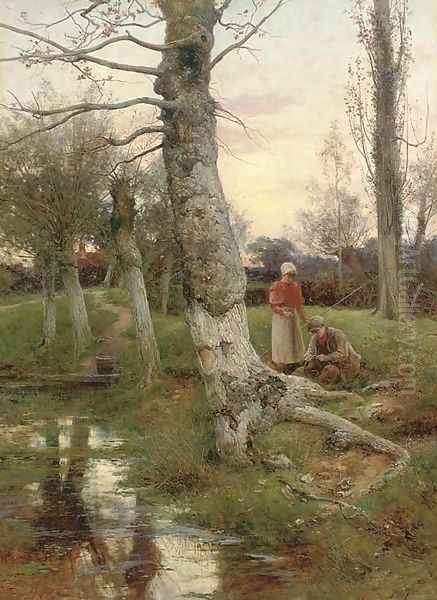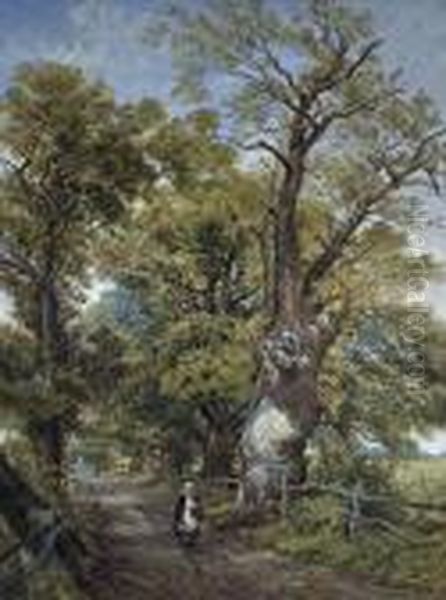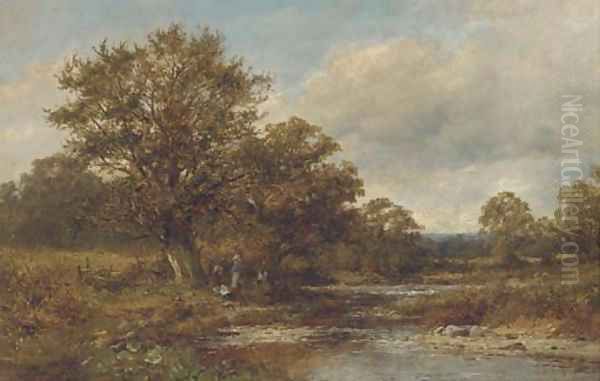David Bates stands as a significant figure in the rich tapestry of British landscape painting during the Victorian era. Active primarily in the latter half of the 19th century and the early 20th century, Bates dedicated his artistic career to capturing the serene beauty and quiet vitality of the British countryside, along with scenes from his travels further afield. His work, characterized by its meticulous detail, vibrant colour palette, and affectionate portrayal of rural life, found favour with the public and secured him a lasting place among the landscape artists of his time.
Born in 1840, Bates emerged during a period when landscape painting was immensely popular in Britain, building upon the legacies of earlier masters while reflecting contemporary tastes. His long and productive career spanned over four decades, during which he consistently produced works that celebrated the natural world and the rhythms of country living. He became particularly known for his depictions of the English Midlands, Wales, and Scotland, though his artistic journeys also took him to continental Europe and beyond.
Early Life and Artistic Foundations
David Bates's artistic journey began not with canvas and oils, but with the delicate art of porcelain painting. Early in his career, he was employed at the renowned Royal Worcester Porcelain factory. This experience proved formative, instilling in him a discipline for precision, a keen eye for detail, and a mastery of applying colour – skills that would translate effectively into his later work in oil and watercolour. Working on intricate floral designs and decorative patterns honed his draughtsmanship and his ability to render fine details with accuracy.
This grounding in decorative arts provided Bates with a strong technical foundation. Unlike some contemporaries who pursued purely academic training, Bates's initial immersion in the world of applied arts gave his work a distinct quality. The meticulousness required for porcelain painting is evident in the careful rendering of foliage, the textures of stone and bark, and the play of light on water that characterize his landscape paintings. This early training distinguished his approach and contributed to the polished finish often seen in his canvases.
Transition to Landscape Painting and Influences

Eventually, Bates transitioned from porcelain decoration to pursue his passion for landscape painting full-time. This move allowed him to explore broader compositions and the atmospheric effects of nature on a larger scale. He worked primarily in oils, but was also proficient in watercolours, exhibiting a versatility common among successful Victorian artists. His decision coincided with a burgeoning public appetite for landscape scenes that offered an escape from the increasing industrialization of Britain.
A key figure often cited as an influence on Bates is Benjamin Williams Leader (1831-1923). Leader, himself associated with Worcester and a highly successful landscape painter, was known for his detailed, often picturesque views of the English and Welsh countryside, particularly scenes featuring silver birches and reflective water. Leader's style, which owed a debt to the earlier naturalism of John Constable (1776-1837) but adapted it to Victorian sensibilities, likely resonated with Bates. The emphasis on careful observation, detailed rendering, and capturing specific light conditions found in Leader's work can also be seen in Bates's own approach.
While influenced by artists like Leader, Bates developed his own recognizable style. He was part of a broader movement of Victorian landscape painters who focused on realistic depiction, often imbued with a gentle sentimentality. This tradition valued craftsmanship and the faithful representation of specific locations, appealing to a wide audience who appreciated recognizable views and skilled execution. Bates operated within this popular tradition, contributing his unique sensibility and technical skill.
Artistic Style and Thematic Focus
David Bates's style is best described as detailed realism, marked by a rich and often luminous colour palette. He possessed a remarkable ability to capture the textures of the natural world – the rough bark of trees, the softness of moss, the transparency of water, and the varied foliage of the British countryside. His paintings often convey a strong sense of place, meticulously rendering specific locations with topographical accuracy, yet also imbuing them with a tranquil, sometimes idyllic, atmosphere.
His thematic focus was overwhelmingly on landscape and rural life. He frequently depicted scenes in the Midlands, particularly Worcestershire, where he had early connections. Wales, with its dramatic mountains, valleys, and rivers, was another favourite location, providing subjects for many of his most characteristic works. Scottish lochs and highlands also featured prominently in his oeuvre. The inclusion of figures – often engaged in quiet rural activities like farming, fishing, or simply resting by the wayside – adds a human element and narrative interest to his landscapes, enhancing the pastoral feel.

Bates excelled at capturing the effects of light and weather. Whether depicting the crisp light of a summer morning, the golden glow of an autumn afternoon, or the more subdued light under a cloudy sky, his paintings demonstrate a careful observation of atmospheric conditions. This attention to light contributes significantly to the mood and realism of his work. Unlike the more dramatic and turbulent landscapes of J.M.W. Turner (1775-1851) or the impressionistic experiments emerging later in the century, Bates's vision remained rooted in a clear, detailed, and often serene representation of nature.
His compositions are typically well-structured and balanced, guiding the viewer's eye through the scene, often using pathways, rivers, or lines of trees to create depth. While detailed, his work generally avoids overwhelming the viewer, maintaining a sense of harmony and peace. This accessible and appealing style contributed greatly to his popularity during his lifetime.
Exhibitions and Recognition
David Bates was a regular exhibitor at major London art institutions, which was crucial for establishing an artist's reputation and securing patronage in the Victorian era. He exhibited frequently at the Royal Academy of Arts (RA) between 1863 and 1893, showcasing numerous landscapes that cemented his public profile. The RA exhibitions were premier events in the London art calendar, and consistent inclusion was a mark of professional success.
Beyond the Royal Academy, Bates also showed his work at other important venues, including the Royal Society of British Artists (RBA) on Suffolk Street and the New Watercolour Society (which later became the Royal Institute of Painters in Water Colours, RI). Exhibiting across these different societies demonstrated his proficiency in both oil and watercolour and broadened his reach among collectors and critics. His works were also shown in provincial exhibitions, particularly in the Midlands, reflecting his connections to that region.
His paintings were generally well-received by the public and acquired by middle-class collectors who appreciated his skillful rendering and pleasant subject matter. Critics praised his fidelity to nature and his technical competence. While perhaps not considered at the forefront of artistic innovation compared to movements like Impressionism that were developing concurrently, Bates was respected as a highly accomplished practitioner within the established tradition of British landscape painting. His work represented a style that remained popular and commercially viable throughout his career.
The enduring appeal of his work is reflected in its continued presence in public and private collections. Museums in the UK, particularly regional galleries, hold examples of his paintings, preserving his contribution to the depiction of the British landscape. His consistent exhibition record over several decades underscores his status as a dedicated and recognized professional artist of his time.
Notable Works

While a comprehensive catalogue raisonné might be extensive, several works exemplify David Bates's style and subject matter. His paintings often carry descriptive titles indicating the location depicted, a common practice among landscape artists of the period.
The Fishing Lesson: Mentioned as achieving a significant price at auction in 2006 (,418), this title suggests a typical Bates theme – a tranquil landscape incorporating figures engaged in a gentle rural pastime. Such works combined scenic beauty with narrative interest, appealing strongly to Victorian tastes.
Blustery Landscape Looking Down River: This title indicates Bates's ability to capture specific weather conditions. It suggests a more dynamic scene than his typically serene views, perhaps showing wind-swept trees and a choppy river, demonstrating his versatility in depicting different moods of nature.
Rural Idyll with Thatched Cottage: This title points to another classic Bates subject – the picturesque English countryside featuring traditional architecture. Thatched cottages were, and remain, potent symbols of a romanticized rural past, and Bates rendered these scenes with charm and detail.
Other typical titles found for his works further illustrate his geographical range and thematic interests:
Harvest Time near Malvern: Depicting the Malvern Hills area in Worcestershire, this likely shows a bustling harvest scene, celebrating agricultural life and the bounty of the land under a warm light.
On the Llugwy, North Wales: The River Llugwy, flowing through scenic areas like Betws-y-Coed, was a popular subject for many Victorian artists, including Bates. His paintings of this area often feature rocky riverbeds, cascading water, and lush woodland.
A Surrey Lane: Representing the gentler landscapes of Southern England, this title suggests a quiet country lane, perhaps shaded by trees, evoking peace and seclusion.
Loch Katrine: This indicates one of his Scottish subjects, likely capturing the renowned beauty of this Trossachs loch, perhaps with mountains rising in the background, showcasing his ability to handle grander, more expansive scenery.
These examples highlight Bates's focus on specific, often identifiable locations, his interest in rural activities, and his skill in rendering the varied landscapes of Britain. His body of work provides a rich visual record of the countryside as seen through the eyes of a dedicated Victorian artist.
Context within Victorian Art

David Bates worked during a vibrant and diverse period in British art history. The Victorian era saw the continued dominance of the Royal Academy, the rise of new artistic movements, and significant shifts in patronage and public taste. Landscape painting remained exceptionally popular, seen as a distinctly British genre, building on the foundations laid by artists like John Constable and J.M.W. Turner earlier in the century.
Bates belonged to a large group of highly skilled landscape painters catering to this demand. His contemporaries included artists like Alfred de Bréanski Sr. (1852-1928), known for his dramatic views of the Scottish Highlands and Wales, and Sidney Richard Percy (1821-1886), part of the Williams family of painters, celebrated for his detailed depictions of mountainous landscapes, particularly in North Wales and Scotland. George Vicat Cole (1833-1893) was another prominent landscape artist, famous for his lush views of Surrey and the Thames Valley.
While Bates shared with these artists a commitment to detailed realism and popular landscape subjects, his style, perhaps influenced by his porcelain painting background, often had a particularly fine finish. His work can also be considered alongside that of watercolour specialists like Myles Birket Foster (1825-1899) and Helen Allingham (1848-1926), who depicted idealized visions of rural England, often focusing on picturesque cottages and charming country scenes, though Bates worked more frequently in oils.
His detailed approach aligns broadly with the Victorian emphasis on close observation of nature, also seen, albeit with different aims, in the work of the Pre-Raphaelite Brotherhood (e.g., John Everett Millais's early landscapes). However, Bates did not share the Pre-Raphaelites' moral or symbolic intensity, focusing instead on the straightforward depiction of landscape beauty. He also differed from artists like John Atkinson Grimshaw (1836-1893), who specialized in atmospheric nocturnal or twilight scenes. Bates's work typically favoured the clearer light of day.
Furthermore, Bates painted scenes of rural life, connecting him to genre painters like Thomas Sidney Cooper (1803-1902), famous for his cattle paintings often set in Canterbury Meadows, or William Shayer Sr. (1787-1879), known for his bustling rustic scenes. Bates's figures, however, usually play a secondary role to the landscape itself. He represented a solid, reliable, and highly competent strand of Victorian landscape painting that appealed to traditional tastes and values.
Later Life and Legacy
David Bates continued to paint into the early 20th century, maintaining his characteristic style even as newer artistic movements like Post-Impressionism began to influence British art. He passed away in 1921, leaving behind a substantial body of work that documents the landscapes he loved with affection and skill. His career exemplifies that of a successful professional artist in the Victorian and Edwardian periods, navigating the exhibition system and finding a receptive audience for his particular vision.
His legacy lies in his contribution to the tradition of British landscape painting. He was not a radical innovator, but rather a master craftsman who excelled within the established conventions of his time. His paintings offer a window into the Victorian appreciation of the countryside, capturing a sense of tranquility and ordered beauty that resonated deeply with his contemporaries and continues to appeal to collectors today. His works are held in numerous public and private collections, ensuring his name endures among the ranks of respected 19th-century British artists.
Bates's paintings serve as more than just topographical records; they convey a genuine love for the British landscape, rendered with a sensitivity to light, colour, and detail. They represent a consistent artistic vision pursued over a long career, celebrating the enduring charm of rural Britain.
Conclusion
David Bates (1840-1921) was a distinguished British landscape painter whose career successfully spanned the late Victorian and Edwardian eras. From his early training in porcelain painting at Royal Worcester, he developed a meticulous technique and a keen eye for detail that he translated into his works in oil and watercolour. Influenced by contemporaries like Benjamin Williams Leader and the broader tradition of British naturalism stemming from Constable, Bates forged a recognizable style characterized by rich colour, careful rendering, and a focus on the tranquil beauty of the countryside.
He was a prolific exhibitor, particularly at the Royal Academy, and his depictions of the English Midlands, Wales, Scotland, and rural life found considerable favour with the public. Works like The Fishing Lesson, On the Llugwy, North Wales, and Rural Idyll with Thatched Cottage exemplify his preferred subjects and appealing style. While operating within the popular traditions of his time, alongside other notable landscape artists such as Alfred de Bréanski Sr. and Sidney Richard Percy, Bates brought his own sensitivity and skill to his canvases. His paintings remain admired for their craftsmanship and their affectionate portrayal of a British landscape that continues to hold nostalgic and aesthetic appeal. David Bates stands as a significant chronicler of the rural scenes of his era.